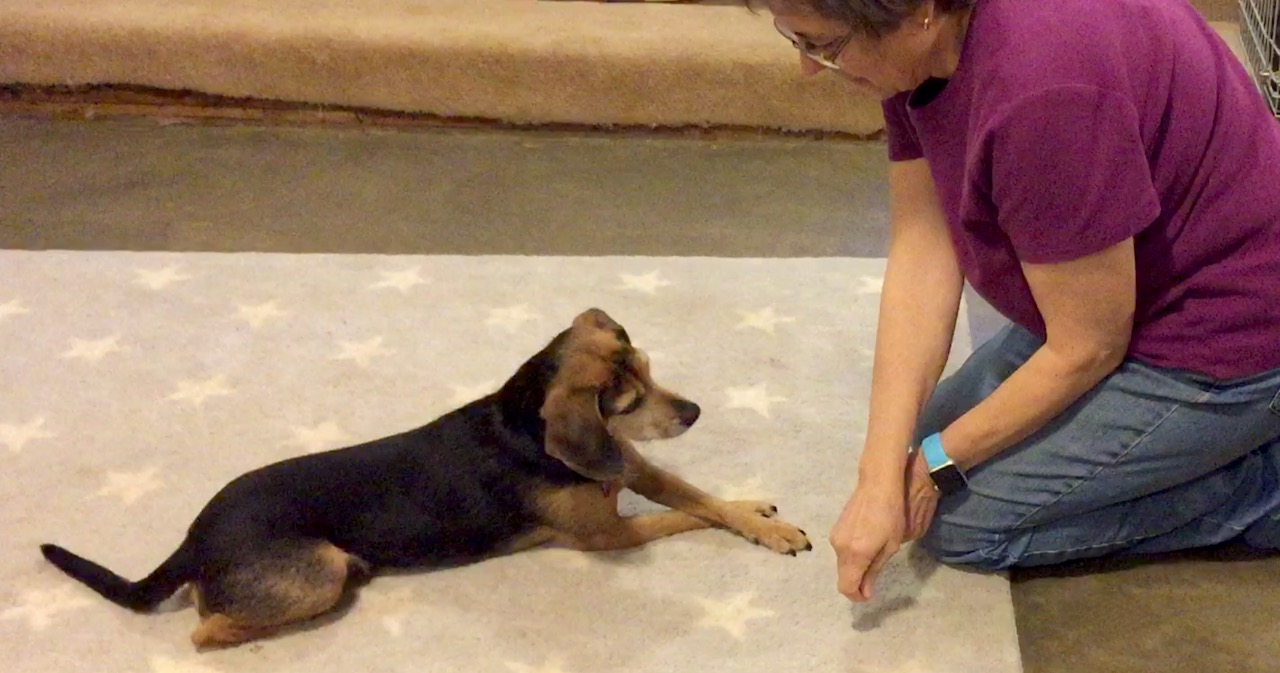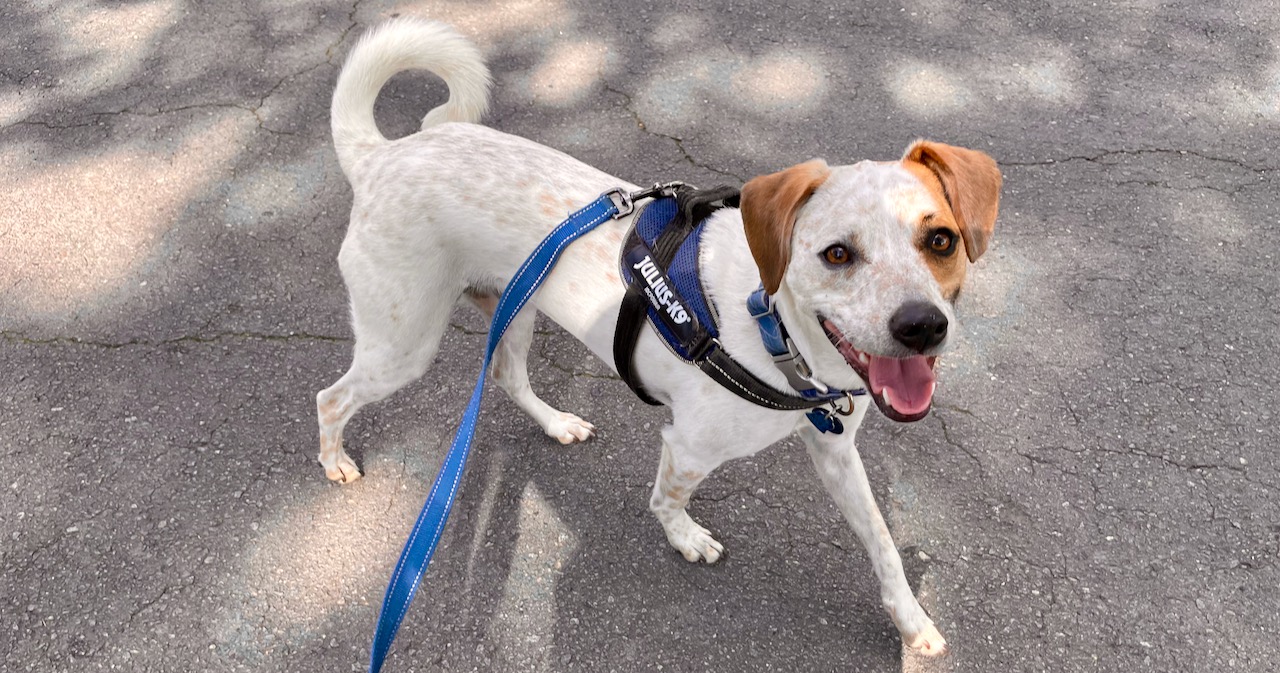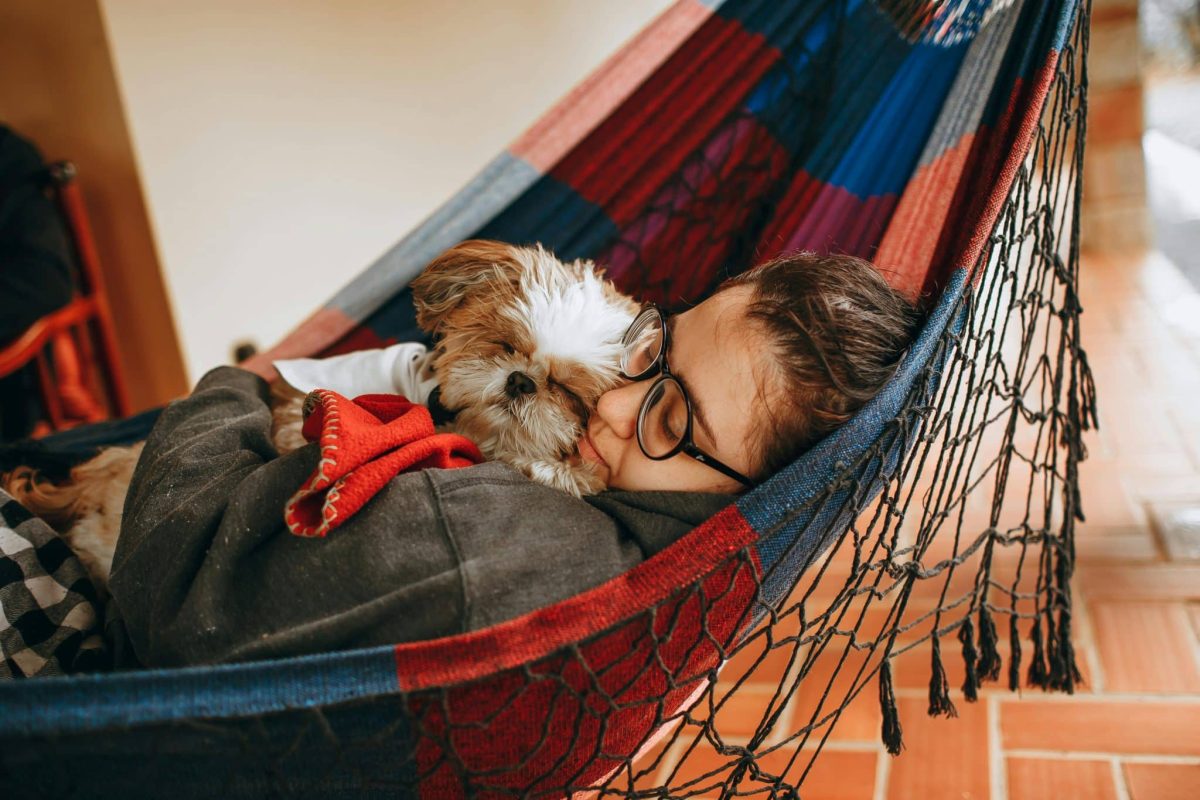This is for people who have started to train their dogs with food. First, good for you! Food is a primary reinforcer, dogs usually love to work for it, it’s handy, and you get a lot of bang for your buck!
If your dog responds only when you have food, nothing is wrong with her. Somewhere along the way, she learned some patterns.
Dogs Are Great Predictors
Here are three patterns of your behavior your dog may have learned.
- If you try to get rid of your food lure after using it a couple of times, and she doesn’t do the behavior without the lure, you may bring the lure out again.
- Even if you don’t normally lure, if she hesitates after you give her a cue, you may touch your treat pouch, show her the food, or even give her some.
- Before any training, you gather up some food, perhaps cut up treats, put them in your pocket or pouch, and go to your usual training place. Dog says, “Yay! This preparation means I get food for doing stuff!” You rarely use food outside of this scenario.
Your clever dog has noted these patterns. One day when you aren’t wearing your treat pouch and you haven’t set up for training, you cue her to perform a behavior. She looks blankly at you and doesn’t move. You don’t have any food to show her, and she continues to stay where she is.
What happened?
She is not being stubborn. She’s not cheating. You have accidentally made “visible food” or “presence of food” an antecedent to the behavior. Food is part of the cue. So when the food is not there, the cue is not complete.
You can fix this.
Isn’t a Cue Just One Thing Like a Word or a Hand Signal?
Most cues have more components than we realize.
What happens if you pick up your dog’s bowl or gather up food toys at a time close to when you normally feed her? She gets excited, right? A meal is coming.
But what if you pick up the same bowl or food toys some other time, not close to a normal mealtime? She may notice or even pay close attention. But she probably won’t leap up, ready to eat. That’s because, besides the bowl and food toys, another part of the cue for “mealtime coming” is the time of day.
The problem is that most of us don’t realize all the things the dog has noticed that come together to create her cues. And if we accidentally leave some of them out, she may not respond. It’s our job either to see that all the components are present, or teach the dog what is and is not important. We’re going to do the latter to fix this problem
A Three-Part Plan
Here’s how you can fix the “dog doesn’t respond when food isn’t present” problem.
You need to show the dog what doesn’t predict food: your treat bag or the smell of food in your pocket, the sight of food, training session preparations, time of day, etc. And you need to show the dog what does predict the opportunity for food: your deliberate cue for a behavior. So here are the parts of the process.
- Clean up training mechanics by properly timing the food delivery and fading lures quickly.
- Show the dog that certain stimuli (e.g. the presence of a treat pouch) do not predict reinforcement on their own. (This process is called an extinction trial.)
- Clarify the cue. We do this by showing the dog there is reinforcement available for performing the behavior after the correct cue, no matter the other conditions.
1. Clean Up Your Mechanics
Set up a camera and video your training. What are we looking for? Cleaning up mechanics is a big topic. What we want is:
- Human delivers cue.
- Dog does behavior.
- Human marks with a clicker or some other marker.
- Human reaches for food.
- Human gives food to dog in one way or another.

So when you watch the video of yourself, make sure you don’t reach for the food or even twitch your hand toward the food until you reach #4. Don’t let your hand drift toward your treat bag as you say the cue or start reaching as the dog does the behavior or as you deliver your marker. That hand stays still until after you deliver your marker, if you use one, or until the correct behavior is in progress if you don’t.
Practice without, then with your dog until your mechanics are clean.
Luring is another common way food can become the wrong kind of predictor. If you use a food lure to get a behavior, you need to stop using it very early in the game. This is called “fading the lure.” Here are two excellent videos by Emily Larlham about that.
The following video focuses on fading the lure.
Dog Training Tutorial: Fading a Lure (while teaching SPIN)
This next video is about fading a lure and adding a cue. What I really want you to see are Emily’s excellent mechanics. Watch her right hand starting at about 3:00. She keeps both her clicker and food in that hand. See how it stays stock still as she uses it to click, and doesn’t move until the dog has done the behavior.
DEMO of removing a LURE and adding a VERBAL CUE
Big thanks to Emily Larlham for having an excellent video on virtually every positive reinforcement training topic.
2. Break the Prediction with Extinction Trials
For a week or two, a couple of times a day, do what you normally do to prepare for a training session, but don’t have one. Cut up food and put it in your pocket or fill up your treat bag. Then continue your business for a while. Work at your computer, do the dishes, work in your yard; do anything but train your dog. When they come and “ask” you about it, acknowledge them, be sweet to them, but do not give them food. This is an extinction process and can be hard on the learner.
If there are other indicators you are about to train, such as gathering gear or going to a certain room, you can decouple them too. Your dog has likely learned them.
You are teaching your dog that when you work with dog food or carry it around, it means nothing in particular. Food is background noise. (But you can still have regular training sessions during this time that you set up in your usual way.)
A trainer friend told me her dogs stopped noticing whether she had her treat bag on or off after she became a professional trainer. Suddenly she was coming and going with the treat bag on, and it didn’t mean anything anymore.
Make yourself a schedule for these times you will wear a treat bag or do other predictive behaviors. Choose different times of day so the dog doesn’t learn a pattern. (They are so good at that!)
Most of us would agree that a dog who thinks they are about to have access to food, then doesn’t, may feel the doggie equivalent of disappointment.
To soften the blow, plan for your first steps to happen when training is unlikely, i.e., when there are cues for competing activities. Examples of such times would be:
- right after you have finished training
- when about to play with your dog with a toy (get the toy first, and make sure no food can fall out of your treat bag!)
- when going for a walk or a ride in the car to somewhere fun (if you don’t normally use food)
- when getting ready for bed
- during human meals, but only if you never feed your dog from the table or shortly after
OK, you haven’t fixed the problem, but you’ve laid the groundwork.
3. Food Can Come from Anywhere
This last essential step is a fun exercise, and is a good thing to teach your dog even if you don’t have problems with them expecting to see the food.
- Have some treats on your person in whatever way is normal for you. Usually, this will be in a pouch or a pocket. Also, have some of the same food in a jar a few steps away (positioned so the dog can’t help himself).
- Ask your dog for a behavior. After the dog performs the behavior, use a marker if you normally do (clicker or verbal marker). Step to the jar (quickly) and reinforce from the treats in the jar. Do not give your dog food from your pocket or pouch.
- Do this in different parts of your house (location can be a big predictor of a training session, too, so mix it up!), but at first, always have the jar very close.
- Gradually reduce the number of treats you have on your person. If you consistently get treats from the jar, carrying food becomes less important. Work your way in steps to an empty, clean treat pouch, then no pouch. Same with pockets: work toward empty pockets in freshly washed clothes. Of course, dogs can smell food on clothes that have been washed, but they can also tell the difference between fresh, present food and the food molecules that remain after washing.
- When your dog responds reliably to your cues when you are not carrying food, start to move farther away from the jar before you cue a behavior. The dog still has a visible “food cue” in the picture, so we want to remove that one, too. So start getting away. Three steps. Five steps. Do this gradually, over several sessions. Finally, the jar is around a corner. Or in a closed cupboard. At the other end of the house. Just inside your back door—and you give the cue outside. Our goal is to teach the dog their behavior makes food appear, whether or not they see the food beforehand.
You can even get fancy and make it so your dog usually gets a better reinforcer when you aren’t carrying food.
After the steps above, you can do most of your training sessions like you always have. But be conscious of your mechanics. And be sure to keep mixing in “remote” treats to keep your dog believing that food cam come from anywhere.. You’ll find it handy to continue to have little caches of food around the house.
Note: This Is Not the Time To “Fade” Treats!
Even if you plan to go to thinner reinforcement schedules and not give your dog a treat after each correct behavior, you should continue to do that while doing the above procedure. If “previewing” food has accidentally become part of the cue for all behaviors, this is a training mechanics error. It’s not a reinforcement schedule issue. Fix your mechanics first. Cleaning up your antecedent arrangement (food being too prominent before the behavior) is separate from thinning a reinforcement schedule (how often food is delivered after the behavior).
You can check out these two posts on reinforcement schedules.
High-Value Dry Foods
Here are some of the foods I use in jars around the house. They are chosen so I don’t have to worry about spoilage.
- Dehydrated lamb or beef lung
- K9 Granola Factory treats
- American Journey Oven Baked Dog Treats
- Stella and Chewy’s dehydrated raw foods
- Lotus oven baked dry food
I also use some other foods with a shorter shelf life for high-value treats. I make sure not to leave them out too long.
Credit for This Idea
Leaving food in containers around the house is not a new or uncommon idea! Neither is the above method for teaching a dog that food can appear from multiple sources. I first read of this practice in two different places: in the old ClickerSolutions Yahoo group, I believe posted by Greta Kaplan, and in Sue Ailsby’s Training Levels. It’s not anybody’s unique system, though. It follows the principles of graduated change, stimulus control, and generalization in behavior science.
Related Posts
Copyright 2024 Eileen Anderson





